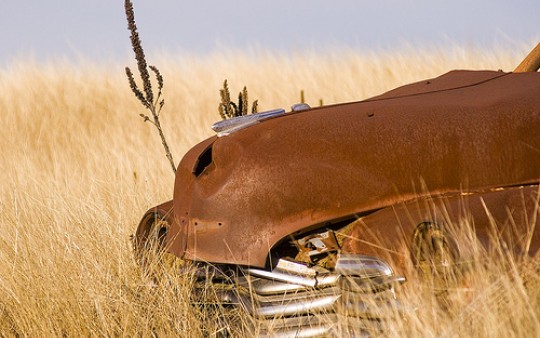Even in the face of the Great Depression, American auto manufacturers seemed to feel that one of the keys to increasing sales was improved convenience. A primary focus was the transmission, and to that end, the auto manufacturers worked to develop simpler means of shifting gears to facilitate the driving experience. Early attempts at alternatives yielded manual-type transmissions that were shifted manually but with an automatic clutch, followed by the first vestiges of the modern fluid-drive automatic, which used a fluid coupling, but usually had only two gears and still required manual shifting, albeit with reduced effort.
The futuristic ideal was a transmission that required only to be set into the desired mode, after which it would handle all shifting duties. While other manufacturers were settling for semi-automatics, Oldsmobile set its sights on the truly automatic transmission, one that would be as reliable as it was smooth. This desire led to an aggressive program to develop a fully automatic, fluid-driven transmission. The program was led by GM engineer Earl Thompson, and the result was the Hydra-Matic Drive, the first fully automatic passenger car transmission.
As projected, the Hydra-Matic used a fluid coupling to transfer power in place of a conventional friction clutch, and three planetary gearsets to provide four forward speeds and reverse. In the absence of a conventional clutch, a parking pawl was included to lock the drive wheels when the engine was off (when the gear selector was placed in reverse), a feature some other automatics lacked into the ''60s.
One area where the Hydra-Matic differs from contemporary automatic transmissions is the fluid coupling, which is not a torque converter, but a torus. A torque converter uses a stator, which allows it to multiply the engine''s torque; a torus does not have this feature. The use of a torus is part of the reason the Hydra-Matic has four speeds; first gear is extra low (3.82:1 on early units, 3.96:1 on later designs) to assist in accelerating from a stop in the absence of additional torque and fourth gear is 1.0:1, not overdrive as found in later four-speed automatics.
The Hydra-Matic made its debut in 1939 as an option on 1940 Oldsmobiles, and turned up on Cadillac''s option list for ''41 (and later, Pontiac''s), but soon after, passenger car production ceased for the war effort. The Hydra-Matic, however, would continue as part of the wartime production, as it found its way into Cadillac-powered tanks (one engine and transmission per track) and some GMC 6x6 military trucks.
That the Hydra-Matic was even considered for such severe use was a testament to its durability, and the success of these applications during the war bolstered its image to the car-buying public, many of whom were still skeptical of automatic transmissions. Advertising claims of the Hydra-Matic''s "battle tested" durability proudly made by GM were no doubt effective in appealing to the public, but the transmission also seemed to develop a reputation within the industry. In fact, before its production ceased, the Hydra-Matic would see use in vehicles produced by Hudson, Nash, Kaiser, Willys, and even under the premium offerings of cross-town rival Ford''s Lincoln division from 1950-''54. Perhaps the most complimentary use of the Hydra-Matic came when Rolls-Royce licensed its design, keeping its slightly altered version in production through 1967.
The Hydra-Matic would experience some revision, most notably the dual-coupling version that debuted for ''56 models as the Jetaway, but it maintained its durability, and was even deemed worthy of competition use. Modified versions formed the cornerstone of well-known Southern California performance transmission company, B&M Racing, which labeled its reworked Hydra-Matic as the Hydro-Stick, and lauded its features as a superior alternative to the manual transmissions that were standard fare at dragstrips across the country in the early ''60s.
But as the ''60s rolled on, General Motors was moving toward more unified production for its divisions, and programs were set in motion to streamline the number of transmissions produced. This push also led to a new generation of automatics, developed by what had become the Hydramatic division of GM. The Turbo-Hydra-Matic 400 was one of the first fruits, serving as a heavy-duty three-speed automatic that combined some of the best elements of previous GM automatics, like the Buick Dynaflow''s torque converter and the Hydra-Matic''s multiple planetary shifting. The Turbo-Hydra-Matic would supplant the Hydra-Matic completely before the ''60s came to a close.
Source: http://www.hemmings.com/hmn/stories/2006/09/01/hmn_feature28.html


